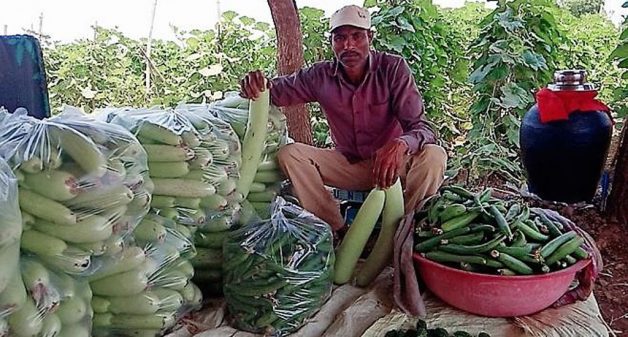
Multi-pronged approach will reboot flagging rural economy
Enhancing the resilience of rural production system through multiple measures, besides soil and water conservation initiatives would help the rural populace find a firm footing

Enhancing the resilience of rural production system through multiple measures, besides soil and water conservation initiatives would help the rural populace find a firm footing
Though unaware of each other’s plight, farmers Tersingh Hathila, Hari Singh Machar and Bheri Madhu Solanki of Madhya Pradesh had a common problem. Hathila could not sell 4.5 tons of wheat because there was no vehicle to transport his produce and the local trader was offering a very low price.
The others’ stories are similar. Solanki had 11 tons of vegetables and Machar had 25 tons of watermelons. As vehicles were not allowed to ply, they could not take their produce to the market or outside traders could not come and buy the same. There was not much scope for local consumption.
Across India, 54 million people are engaged in crop cultivation, and 93 million work as casual labor. About 3 million are involved in driving, loading, unloading and other non-agricultural activities. The severity can be understood from the number of people dependent on the works on an everyday or seasonal basis.
Measures such as restoring rural and agricultural supply chains, commitment to purchase agricultural produce at assured prices, and speeding up of MGNREGA works, etc. will help in rebooting the rural economy.
Empty pockets
In an individual household with different share of activities, 80% of the household income comes from cultivation, wages and salary. Another crucial area of earning is livestock, which has also been hugely affected due to the lockdown.
While there is unrest among migrant workers, first to try and reach home, the next concern is loss of income. The sudden outbreak of pandemic has put a stop to many rural aspirations and halted many opportunities.
Casual work wages contribute about 40% cash income for households. The lockdown has resulted in loss of this income. As the migrants’ first priority was getting back to their villages, they returned with negligible or no cash. The only source and support is from the government or civil society.
Declined earning
While the lockdown has weakened the rural economy, the possibility of generating income from small amount of cash crops is unavailable. The supply chain has been disrupted and the consumption in local and regional markets is low.
While the months of March, and April are considered to be the peak season for high value crops such as flowers, vegetables, watermelons, mangoes, jackfruit and tamarind, uptake to terminal markets has been negligible.

Prices dipped significantly and there is no demand for these high value crops. Regular consumption items have also seen notable reduction in prices. Green chilies are being sold for Rs 8 per kg, in the mandis of Jharkhand. Experts predict that the next earning from farming is at least six months away.
Investment constraints
The rabi harvest is complete, but due to reduced price and lack of required labor, the sales have largely been uncertain.The problem exacerbated since the local people did not allow traders from outside due to distrust and fear.
The problems farmers faced in selling their produce will reflect in the amount they can invest for the kharif crop. Shortage of farm labor is likely to continue. As movement of farm inputs is also restricted, there would be shortage of inputs.
Suresh Bundela of Bagliya village in Madhya Pradesh had a lot of difficulty in selling his 20 tons of bottle gourd. The local trader offered very low price for the vegetable. This has resulted in lack of resources to buy inputs and sow his summer crop of cotton.
Way forward
With a multi-pronged approach, the rebooting of rural economy can be made possible. Relief work focusing on food and shelter should continue, ensuring that no one goes hungry.
Rural communities still do not have enough awareness about the pandemic. There are a lot of myths and misconceptions regarding COVID-19. There needs to be an intense educational effort to reach these communities with the right information.
It is imperative to fix the broken supply chains, enabling local entrepreneurs with sale of local produce in the community. With an intact supply chain, smallholders can be encouraged to face the current challenges. The unrest can end with assured price commitments and lifting of produce in the market.
Grant support and easy credit can be facilitated to ensure cash in the hands of producers. MGNREGA activities need to be accelerated. Wage days and wage rate should be increased and job cards should be created at the earliest. Skill mapping and activity based funding should be facilitated.
Soil and water conservation interventions need to be taken up. Personal asset creation should be facilitated. Self-help groups may be roped in for supply of agricultural inputs, just as they were, for production of masks.

Considering the restricted interstate movement and constricted demand by hospitality industry of highly perishable commodities such as flowers, exotic produce, etc. farmers can be advised to grow alternative crops. Digital skills of farmers as well as migrants should be enhanced.
Livestock rearing should be considered an integral part of small holder farmers. Resilience of the local production system should be enhanced through crop diversity, near farm value creation, besides enhanced energy access and irrigation for smallholders.
Palak Gosai is a researcher at VikasAnvesh Foundation, Pune.
This write-up is an outcome of the webinar conducted on 21 April, by Transform Rural India Foundation (TRIF) on rebooting the rural economy. Sanjiv Phansalkar of VikasAnvesh Foundation(VAF) and Vinay Kumar of TRIF anchored the discussion. The panelists were Ashis Mondal, Action for Social Advancement; Sanjeev Asthana, I-Farm Venture Advisors; Sanjeev Kumar, The Goat trust and Ashok Kumar, TRIF.